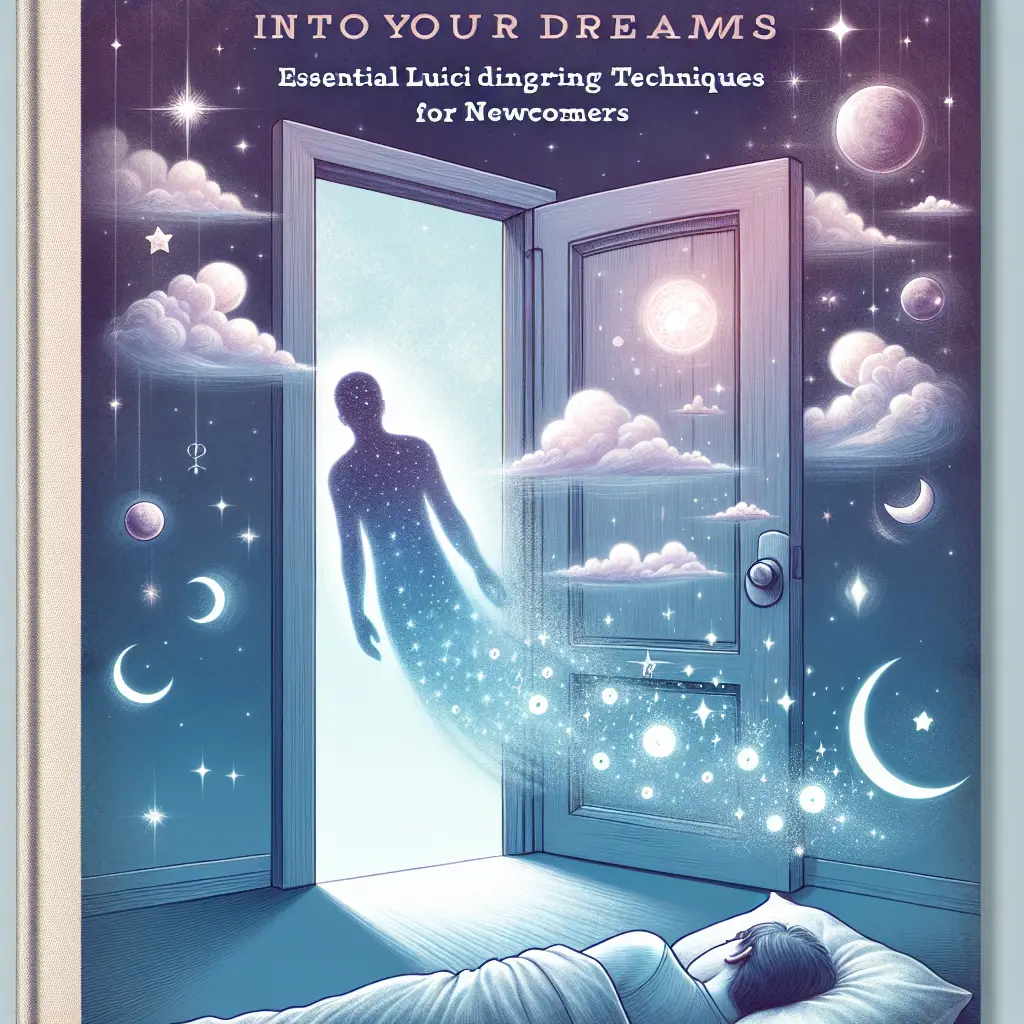
Step into Your Dreams: Essential Lucid Dreaming Techniques for Newcomers
Introduction
Picture this: you’re floating above a beach, feeling the soft wind on your face, the sun warming your skin, and the sound of waves lapping gently against the shore—all while being fully aware that this is a dream. This extraordinary state is known as lucid dreaming, a powerful technique that enhances creativity, self-discovery, and stress relief. If you’re eager to explore the cosmos of your mind and "Step Into Your Dreams", this guide is your gateway. We delve into the essential lucid dreaming techniques for newcomers, helping you navigate this fascinating world that blends dreams with reality.
For many, lucid dreaming offers a unique opportunity to overcome fears, enhance skills, or simply have fun. By adopting practical techniques, you can become the master of your dream universe. Let’s embark on this journey into your subconscious.
Understanding Lucid Dreaming
What is Lucid Dreaming?
Lucid dreaming occurs when an individual becomes aware they are dreaming while they are still within the dream state. Triggered by this realization, the dreamer can exert a degree of control over the dream’s narrative, environment, and even their own actions. Essentially, lucid dreaming allows you to step outside the boundaries of reality and explore a world shaped by your imagination.
The Benefits of Lucid Dreaming
The benefits of lucid dreaming extend beyond mere exploration. Here are some compelling reasons to step into your dreams:
- Enhance Creativity: Many artists and innovators use lucid dreaming to visualize concepts and solve problems.
- Overcome Nightmares: With awareness and control, you can confront fears and change negative dream scenarios.
- Skill Improvement: Athletes and performers often use lucid dreams to rehearse and improve their skills in a risk-free environment.
- Emotional Well-being: Lucid dreaming can serve as a significant tool for stress relief and emotional regulation.
Essential Techniques for Newcomers
1. Reality Checks
One of the most fundamental techniques in the journey of lucid dreaming is practicing reality checks. This involves regularly questioning whether you are awake or dreaming throughout your day. Common reality checks include:
| Technique | How to Perform |
|---|---|
| Finger Check | Try to push your finger through the palm of your hand. In dreams, your finger may pass through. |
| Nose Pinch | Pinch your nose and try to breathe through it. If you can, you’re dreaming. |
| Clock Check | Look at a clock, look away, and then look back. If the time changes drastically, you may be dreaming. |
Through consistent implementation of reality checks during your day, you’ll begin to incorporate them into your dreams—enhancing your chances of recognizing when you are dreaming.
2. Dream Journaling
Keeping a dream journal is a critical step to stepping into your dreams. By writing down your dreams immediately upon waking, you can increase dream recall, recognize patterns, and better identify your dream signs—elements that frequently appear in your dreams.
How to Start a Dream Journal:
- Keep a notebook by your bed.
- Upon awakening, jot down everything you remember about your dream: feelings, colors, people, and events.
- Review your journal regularly to identify common themes or signs that can signal lucidity in future dreams.
3. Meditation and Visualization
Meditation is a powerful tool for developing awareness and focus, two essential pillars of lucid dreaming. Engaging in mindfulness meditation can improve your ability to recognize when you are dreaming. Additionally, visualizing your dream goals before sleep can help prime your mind for lucid experiences.
Steps for Evening Meditation:
- Find a comfortable, quiet space.
- Close your eyes and focus on your breathing for 5-10 minutes.
- Visualize a specific dream scenario where you become aware of your lucidity. Imagine the actions you will take and how you will feel.
4. The Wake-Back-to-Bed Technique (WBTB)
The Wake-Back-to-Bed technique is an effective method to induce lucid dreams. This technique involves waking up after 5-6 hours of sleep and staying awake for a brief period before returning to bed.
How to Implement WBTB:
- Set an alarm to wake you after 5-6 hours of sleep.
- Stay awake for 20-30 minutes—engage in reading about lucid dreaming or write in your dream journal.
- Return to sleep with the intention to lucid dream.
5. mnemonics for Lucid Dreaming (MILD)
The Mnemonic Induction of Lucid Dreams (MILD) technique is a powerful method for increasing your chances of achieving lucidity. This strategy involves repeating a specific affirmation or intention before you sleep.
How to Practice MILD:
- While falling asleep, repeat a phrase like “I will realize I’m dreaming.”
- Picture yourself becoming aware in a dream scenario.
- Focus on your intention to lucid dream, setting a strong mental cue for your subconscious.
6. Lucid Dream Induction Devices
For those technologically inclined, various devices claim to aid in lucid dreaming by providing sensory cues during REM sleep. These devices use gentle lights or sounds to prompt awareness without waking you.
| Device Type | Description |
|---|---|
| Smart Sleep Masks | Masks that emit soft light at the onset of REM sleep. |
| Smart Alarm Clocks | Clocks that wake you during lighter stages of sleep. |
While these devices can be beneficial, remember that they’re most effective when combined with personal techniques like reality checks, journaling, and meditation.
Case Studies in Lucid Dreaming
Case Study 1: Overcoming Nightmares
Background: A 12-year-old boy battled frequent nightmares, which led to fear of sleep and impact on his daily life.
Technique Used: The boy’s therapist introduced lucid dreaming techniques, including practicing reality checks and maintaining a dream journal.
Outcome: After months of practice, the boy began to recognize the dream scenarios, allowing him to confront his fears and ultimately control the narrative of his nightmares. His frequency of nightmares decreased significantly, leading to better sleep quality.
Analysis: This case highlights how lucid dreaming can transform nightmares into a source of empowerment, illustrating a practical application of the techniques discussed.
Case Study 2: Enhancing Performance Through Lucid Dreaming
Background: A professional basketball player sought to improve his free-throw shooting skills.
Technique Used: He applied the MILD technique, visualizing successful shots before sleep.
Outcome: After weeks of practice, the player noticed an improvement in his shooting accuracy, attributing part of his success to rehearsals conducted in his dreams.
Analysis: This case demonstrates how lucid dreaming can serve as an advantageous practice platform, enabling skill enhancement through mental visualization.
Tips for Successful Lucid Dreaming
- Stay Patient and Curious: Like any skill, lucid dreaming takes time to master. Celebrate small victories.
- Establish a Sleep Routine: Prioritize adequate sleep to improve dream recall and clarity.
- Join a Community: Connect with fellow dreamers online for shared experiences, tips, and motivation.
Conclusion
Stepping into your dreams is more than just a notion; it is a journey into the expansive landscape of your subconscious. With the essential lucid dreaming techniques discussed, such as reality checks, dream journaling, and the power of intention, you are well on your way to maximizing your dreaming experiences.
The exploration of lucid dreams can unlock creativity, resolve internal conflicts, and even improve life skills—ultimately enriching your waking life. Remember, with practice, patience, and perseverance, you can master the art of lucid dreaming and unlock the door to your wildest aspirations.
FAQs about Lucid Dreaming
1. Is lucid dreaming safe?
Yes, lucid dreaming is generally considered safe. However, individuals with certain mental health conditions should consult a professional before diving into lucid dreaming practices.
2. How long does it take to become proficient in lucid dreaming?
The time can vary greatly among individuals. Some may experience lucidity quickly, while others may take weeks or months of practice.
3. Can everyone lucid dream?
Most people can learn to lucid dream, but some may find it easier than others due to individual differences in dream recall and awareness.
4. Will I remember my dreams better if I lucid dream?
Often, practicing lucid dreaming leads to improved dream recall because you become more attuned to your dream experiences.
5. Can I control my dreams completely?
While many dreamers enjoy a high level of control, not every dream can be controlled fully. This level of control often improves with practice.
By utilizing these insights and techniques, you are equipped to embark on a transformative journey through your dreams. So, take a deep breath, set your intentions, and prepare to step into your dreams. Happy dreaming!















